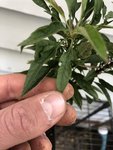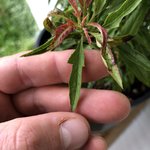milehigh_7
Mister 500,000
He is @Brent here. Cryptic, right?
LOL!
He is @Brent here. Cryptic, right?
How did you germinate the seeds?So this past fall I collected lots of crabapple seed from three different trees around my city, Ithaca, NY. There are a wide variety of crabapple cultivars planting in my city as street trees, some of them are quite old, so I feel the cross pollination between all these trees could explain the amount of genetic diversity I’ve seen in the seeds I started. I started the seeds this spring after cold stratifying in my fridge and now I have probably two hundred something crabapple seedlings.
As luck would have it I have identified three incredibly unique dwarves amongst the bunch. Just wanted to share these little guys with you all. My hope is that they all survive the winter and I can start propagating them in the future, and patent them as unique cultivars. Also if anyone knows anything about patenting a plant cultivar I would be interested in that info.
Here we go, here are the three dwarves next to some of the non dwarf crabapples from the same batch of seeds, for perspective.
Dwarf number 2: really tiny leaves with bright red stems. The leaf shape is not smooth and is somewhat reminiscent of some hawthorn leaves.
Dwarf number 3: also super tiny leaves, stems are a darker red, and leaves are a really gorgeous dark green.
I’m really hoping #2 and #3 can put on some more growth before winter, but their growth rate is understandable given their minute leaf size. I plant to build some top of cold frame this fall and all three of these will go in there for added protection. Any thoughts, suggestion, comments are welcome!
View attachment 201990
Aha but you DID know though! There may be more educated individuals on here than you two, true, but you both are very generous in sharing the info. So thank you.@Mike Hennigan
Nice project, and with patience, could really be something great. As to patenting plants, I last looked into it a decade or more ago, and decided it wasn't worth the expense as a hobby grower. It takes some cash, and it takes time, roughly 5 more so years from beginning the patent application to receiving the patent. You then have the cost of policing the violators yourself. There are no ''patent police'', you have to spend the time. Average patent fee is usually less than $2 per plant, most run about $1.10 or so for woody trees and shrubs. For perennials the fee you can collect is less, often around $0.25. But this is from memory rather than current information. If you can partner with a major nursery having them do the propagation, you might have a good set up. But all this is moot until you actually get the seedlings up to size enough to begin to test their traits.
@JoeR - there are many here who know more than me, I'm just willing to spend the time typing. I'm a sucker for flattery, you got me to respond.
Brent Walston is the man I take my hat off to for all things propagation. Much of what he knows is shared freely on his website, in the articles archive. http://www.evergreengardenworks.com/articles.htm
Apples, and crab apples are notorious for seedlings taking a long time to first bloom. While there are a few seedlings that will bloom in as little as 5 years, or whatever the ''internet'' promised, the majority will take 10 years or more. A full 30 years is not unheard of. So of your 300 seedlings, expect maybe one or two to bloom quick, majority around 10 years and maybe a third will take near or more than 20 years. Key to getting a seedling apple, or crab apple to bloom quickly is unrestricted growth. This is of course, contrary to the goals of bonsai. So even if you have a seedling that potentially could bloom in 7 years, if you grow it in a container, it will likely take quite a bit longer.
Commercial apple breeders try to get around the slow to bloom problem by grafting. They will bud graft of the seedling being tested onto commercial understock. Then plant it out in their nursery test plots. The scion will often bloom in about 5 years from grafting even if the original seedling won't get around to blooming for many years. Grafting onto normal rootstock would be a good way to test the dwarf growth characteristics of your special seedlings. If you are careful about keeping scions labeled, you can graft all three of your special seedlings on a single understock. Save space that way. But if you can not ground grow your grafted tree it won't save you time. Also while grafting ''can'' get the seedling to bloom in as little as 5 years, it is not guaranteed, some seedlings are just stubborn, and no matter what you do will want to take their own time to get around to blooming.
How did you germinate the seeds?
@Mike Hennigan
Nice project, and with patience, could really be something great. As to patenting plants, I last looked into it a decade or more ago, and decided it wasn't worth the expense as a hobby grower. It takes some cash, and it takes time, roughly 5 more so years from beginning the patent application to receiving the patent. You then have the cost of policing the violators yourself. There are no ''patent police'', you have to spend the time. Average patent fee is usually less than $2 per plant, most run about $1.10 or so for woody trees and shrubs. For perennials the fee you can collect is less, often around $0.25. But this is from memory rather than current information. If you can partner with a major nursery having them do the propagation, you might have a good set up. But all this is moot until you actually get the seedlings up to size enough to begin to test their traits.
@JoeR - there are many here who know more than me, I'm just willing to spend the time typing. I'm a sucker for flattery, you got me to respond.
Brent Walston is the man I take my hat off to for all things propagation. Much of what he knows is shared freely on his website, in the articles archive. http://www.evergreengardenworks.com/articles.htm
Apples, and crab apples are notorious for seedlings taking a long time to first bloom. While there are a few seedlings that will bloom in as little as 5 years, or whatever the ''internet'' promised, the majority will take 10 years or more. A full 30 years is not unheard of. So of your 300 seedlings, expect maybe one or two to bloom quick, majority around 10 years and maybe a third will take near or more than 20 years. Key to getting a seedling apple, or crab apple to bloom quickly is unrestricted growth. This is of course, contrary to the goals of bonsai. So even if you have a seedling that potentially could bloom in 7 years, if you grow it in a container, it will likely take quite a bit longer.
Commercial apple breeders try to get around the slow to bloom problem by grafting. They will bud graft of the seedling being tested onto commercial understock. Then plant it out in their nursery test plots. The scion will often bloom in about 5 years from grafting even if the original seedling won't get around to blooming for many years. Grafting onto normal rootstock would be a good way to test the dwarf growth characteristics of your special seedlings. If you are careful about keeping scions labeled, you can graft all three of your special seedlings on a single understock. Save space that way. But if you can not ground grow your grafted tree it won't save you time. Also while grafting ''can'' get the seedling to bloom in as little as 5 years, it is not guaranteed, some seedlings are just stubborn, and no matter what you do will want to take their own time to get around to blooming.






Plant patents are pretty expensive as Leo says, between $10 and 20k plus the yearly costs for monitoring the marketplace and enforcing the patent rights by a group that does that, maybe $2k per year. Without enforcement, it's worth nothing. It has to be renewed every five or so years for about $5k. And it takes DNA or otherwise testing to identify the specific characteristic you are patenting. That process will be costly enough, and the lawyers doing the patent searches and filing aren't cheap, but the ongoing government filing fees are pretty stiff, too. If you don't see a revenue stream of $20k/yr, it won't work. Remember, that doesn't include the costs of producing and marketing a single tree.
As to whether you can find a grower who would put up the money, etc., and pay you a royalty, there are thousands of trees they can produce, probably hundreds and hundreds of Crabapples, for nothing. Your tree would have to be spectacular in some way.
Hey Mike,
Looking good. The survivor still looks unique as far as crab apples go. Wonderful short internodes. Outstanding.
Leo
The dwarf crab from my last post with photos is really bushed out and much bigger. I potted it into a 2 or 3 gallon pot. Will take a photo when I get a chance.It's there any update on this
Have you been able to take cuttings or has it been exclusively growingThe dwarf crab from my last post with photos is really bushed out and much bigger. I potted it into a 2 or 3 gallon pot. Will take a photo when I get a chance.
no cuttings yet. Just growing. I wanted to get it big and healthy before I try to propagate it.Have you been able to take cuttings or has it been exclusively growing
Root cutting are a good option in Malus keep it in mind in future repotingsno cuttings yet. Just growing. I wanted to get it big and healthy before I try to propagate it.






